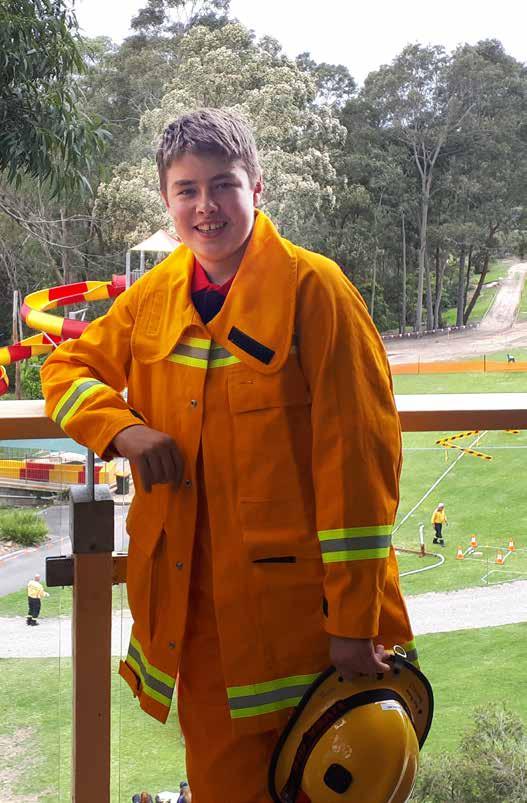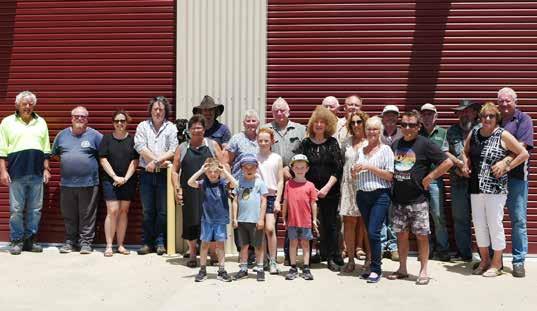
15 minute read
Small community embraces technology
Small community embraces tech to stay safe
Thanks to a $40,000 donation from Inner Wheel Australia, Bemm Fire Brigade is leading the way when it comes to the latest in sprinkler technology. The money was donated by German clubs of the international association after last year’s devastating bushfire season, with a proviso it be used to protect communities affected by bushfire. Inner Wheel is an International women’s volunteer service organisation which promotes friendship, the ideals of personal service and to foster international understanding. Inner Wheel Australia Council Member Kate Luxford said she was proud Inner Wheel Australia chose to fund the project from international donations. “With many of our international clubs keen to help aid the bushfire recovery, donations came from across the world,” she said. “A large donation came from members in Germany who earmarked their money for use by the volunteers in the more rural fire brigades that were affected by the devastating bushfire season. “After numerous phone calls around the districts, I spoke to Bemm Fire Brigade Captain Russell Pardew. After hearing about his wish to install a proven sprinkler system, I knew some of this donation would be spent well and be greatly appreciated. “I was proud when my submission to the Inner Wheel Australia Executive was accepted and they chose to fund the project for the sprinklers.” Captain Russell Pardew said the brigade wanted to make the most of the donation to help future-proof their station. “I talked to Kate about what we could do with the donation to make it meaningful. I felt it was important that we invested that donation wisely and stretched it as far as we could,” Russell said. “I came up with an idea a while ago to have a sprinkler system installed at our station. After getting quotes, I realised the donation would actually cover more than one system and I thought of a couple of smaller brigades in District 11 that could use some help. “One small community that has been belted by fire over the past 10 years is Goongerah. We also thought we could help out Wariewa, a small rural community between Orbost and Lakes Entrance.” The sprinkler system is tailored for each location. It runs for two hours and is a reticulation system where half the water used runs back into the tank. In Bemm they will be able to activate it remotely using a mobile phone. Where there is less mobile coverage, such as at Goongerah, there’s a heat sensor that will activate the sprinkler when it’s needed to protect the building. For more remote brigades, a diesel pump powers the sprinklers. At Bemm brigade they have an electric power generator that kicks in if the power fails. Russell said this was important in any small town where the fire brigade often becomes the central emergency point where people gather, particularly with tourists around. “Someone said it’s an insurance policy for a CFA property, and I think that’s a good description,” he said. Russell said smaller communities had to find innovative ways to be more resilient, because outside help was not always readily available. Bemm has a permanent population of around 65 that rises to about 400 to 600 people in the peak tourism seasons of Easter and Christmas. It has one road in and one road out so can easily become isolated during the fire season. “You have to think outside the square. Bemm was the first brigade to use slip-on units,” Russell said. “We’re keeping that up by being the first to create our own 100-metre firebreak. We have also created our own helipad. “Communities should decide what best suits their needs. It’s a lot of work and effort to maintain and keep up interest in a local fire brigade. I’d encourage communities to support their local brigades. “Our local relationships with councils, DELWP and other agencies is also critical to this mission. We work together to keep up the persistence and momentum to make our communities as resilient as possible.” CFA supported the sprinkler project with an additional $11,000.
Advertisement
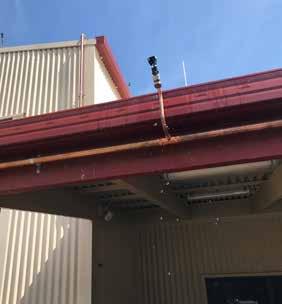
Eaglehawk Citizen of the Year 2021
Former Eaglehawk Fire Brigade Captain Eric Smith, who was instrumental in protecting the community during the 2009 fires, has received the honour of Eaglehawk Citizen of the Year for 2021. The award recognises Eric’s service to CFA for more than 50 years, his involvement in various community events, and membership of organisations including Eaglehawk Dahlia and Arts Festival, Canterbury Carols and Australia Day Committee. Eric is a highly decorated CFA member having held several roles at Eaglehawk from training officer and coordinator, second lieutenant, group delegate and captain for six years. “Eric is a fine example of putting service above self and he’s highly regarded for his community passion and people skills,” said Geoff Gallagher, Community Services Director with Rotary Eaglehawk. “In 2009, Eric was on the first fire truck to fight fires on what became known as Black Saturday, and he worked on the ground for several weeks to protect our community. “On behalf of the Eaglehawk community and the Rotary Club of Eaglehawk, I congratulate Eric on becoming this year’s Citizen of the Year and thank him for his dedication to his community.” Several brigade members caught up with Eric, commonly known as Uncle Eric, to have a chat about the recent announcement. “I received a phone call from the organiser of the Eaglehawk Australia Day Committee saying I had been awarded Eaglehawk Citizen of the year for 2021,” Eric said. “It really caught me off guard, quite a shock really. “I try to keep a low profile and just work along in the background helping with what needs to be done,” he continued. “It’s for the Eaglehawk Community, it’s what you do being part of the community, but I do humbly appreciate the award.” Eric reflected on the time after Black Saturday and noted how the community of Eaglehawk “fell into place and helped the brigade immensely. “It really helps having a great team and family supporting me, and I find it satisfying seeing the community come together, whether after a fire or at the Dahlia and Arts Festival.” “On behalf of Eaglehawk Fire Brigade, we congratulate you Uncle Eric on becoming this year’s Citizen of the Year and thank you for your dedication to Eaglehawk Fire Brigade and the Eaglehawk community,” brigade Captain Kylie Davis said.

Fire station becomes a power station
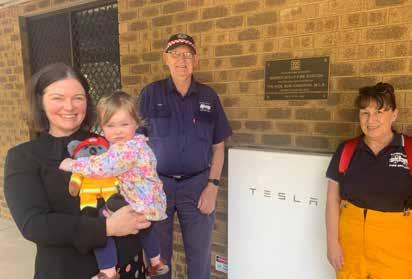
Maiden Gully Fire Station has a new solar energy installation comprising 6.6kW of solar panels on the engine bay roof along with a 13.5kWh Tesla Powerwall battery. This was made possible thanks to funds from the Australian Government’s Energy Efficient Communities Program, Bendigo UFS Healthier Communities Program and Maiden Gully IGA Community Chest Program. “Rather than needing an emergency generator, this power station provides electricity for lighting, communications and other equipment during power outages,” Captain Peter Dole said. “It has already proved itself on the first extreme fire danger day last season when there was a power outage for almost three hours. “Normally the station uses a minimum of energy, so it’s now a net exporter of power to the grid, virtually eliminating power bills. “In effect, our fire station has become a power station.” A key partner in the project was the Bendigo Sustainability Group (BSG) which identified the grant opportunity, sorted the technical specifications and arranged quotes. “Together, we’ve delivered an installation that will greatly reduce our environmental footprint through saving at least 6.8 tonnes of greenhouse gas emissions annually,” Peter said. You can watch the system being installed on YouTube: https://youtu.be/ZnL7LFjCqt0.
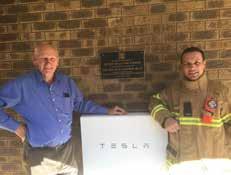
1
2
Left: BSG’s Colin Lambie with brigade Captain Peter Dole in front of the battery Below: Lisa Chesters MP, Member for Bendigo, with firefighter John Ham and Lieutenant Holly Franchina


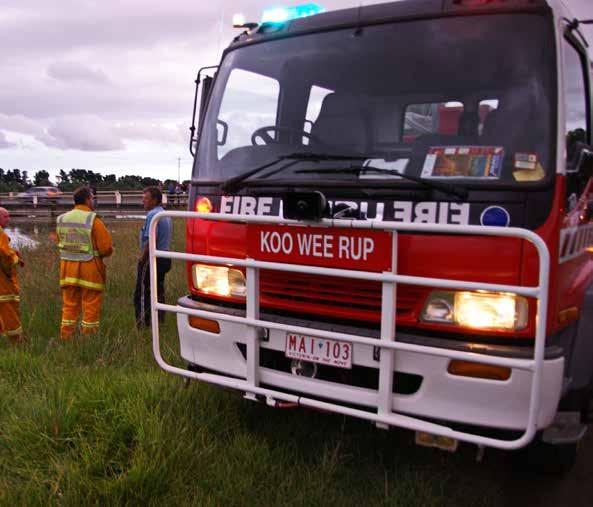

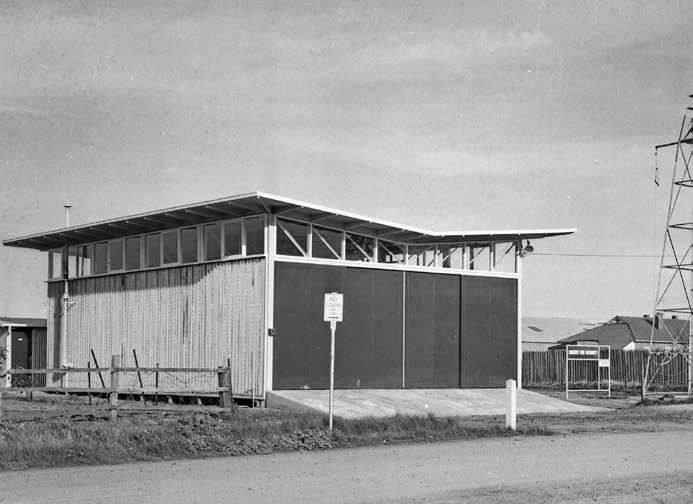


5 3
7
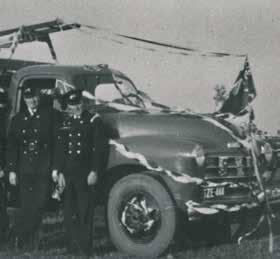


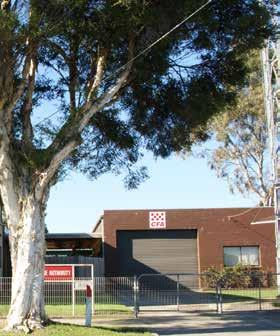

8
THROUGH THE AGES KOO WEE RUP
1 Main drain flooding, 2011 2 Township celebrations, 1953 3 Ladies Auxiliary 4 Fire station built in 1958 5 Current fire station 6 Blind BA training 7 Champs team 8 Brigade-owned ultralight 9 Koo Wee Rup railway station fire, 1994 10 Working with SES during floods, 1990s 11 Brigade fire education with schoolchildren
COMPILED BY KEITH PAKENHAM AFSM
11 10

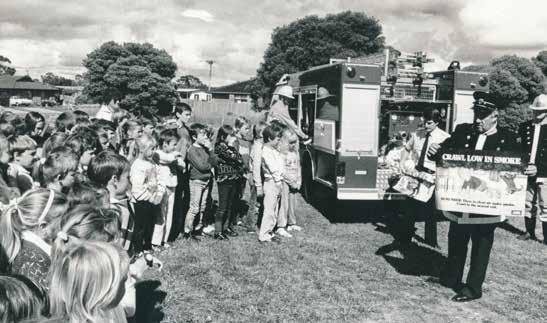
A Beacon of light in Beaconsfield
It’s been a tough 12 months for Junior brigades. While some adapted to running Juniors online, others found that young members were being overloaded with screen time through school and put their Junior Program on hold – which is what Beaconsfield Junior Brigade did. But that didn’t mean the Juniors were forgotten about. The Junior leaders shared ideas about how to engage the Juniors remotely and turned to social media to stay in contact. “We all kept in touch through our private Facebook group, offering peer support and help when required,” Junior Coordinator Jason McKenzie said. However, when the green light was given on meeting together, Juniors were contacted and they had their first session that same week. What made it even better was the addition of new recruits despite the program not running as normal during 2020. Jason’s daughter, Brooke, pictured right, was one of them. “I joined the Juniors to have fun and learn about firefighting,” Brooke said. “I love spending time with my dad and it’s something we can do together. It also gives mum a night off with peace and quiet.” “Recruiting members is always hard but we were fortunate to have siblings of existing members coming though,” Jason added. “We also approached Beaconsfield Primary School and carried out an information session about the program.” The Junior leaders continued to use the brigade Facebook page to advertise the Junior brigade and encourage young people to join. This combined approach resulted in four new Junior members who started at the beginning of the year. Beaconsfield Juniors Program focuses on making sure the kids have fun while learning core firefighting activities. Sessions are built around normal duties but tailored to suit the Juniors’ skill levels. The Juniors enjoy activities that involve hands-on running the pumps and using heaps of water. They also have a special love for the brigade’s ground monitor, which is always fun for them to set up. It’s not all just about having fun though, as Jason explained. “A lot of the Juniors are also really pleased to be doing something that can help the community.” The Junior leaders at Beaconsfield believe a varied program is key to keeping the Juniors engaged. Plans are in the works for a visit to Eildon Fire Brigade to explore its fire boat and maybe even go for a ride. In the past, the Juniors have been visited by the Chief Officer and have toured Dandenong Fire Station including a trip up the ladder platform. The Juniors program has good support from neighbouring brigades Berwick, Officer and Upper Beaconsfield, who help with training nights and refer local young people to the program because they don’t have one. So what’s Jason’s advice to any leader who wants to develop plans for their Juniors? “Get on the phone and make it happen. It’s amazing how helpful other brigades are when it comes to helping the kids.”
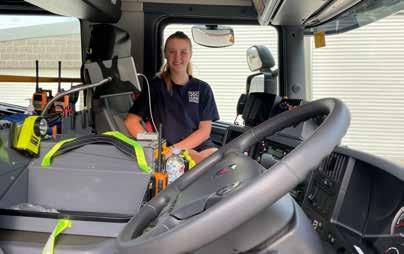
STORY JEN CLEMENT AND JASON MCKENZIE

A heads-up on mental health
Grady Tyson, a young volunteer from Tatura Fire Brigade, is representing CFA volunteers on the Young Volunteer Advisory Committee. He’s involved in a research project being done by the University of Adelaide looking at identifying effective strategies to maintain the mental health and wellbeing of young fire and emergency services volunteers aged 16 to 25. “I thought getting involved in a mental health research project and sharing opinions over Zoom as an emergency services volunteer would be an easy way to stay social and engaged through lockdown,” Grady said. The project has gathered youth representatives from the SES, RFS, QFES and CFS, among others, to discuss how different organisations respond to trauma situations such as traumatic callouts, debriefing processes, counselling services, and attitudes about the importance of good mental health. The Advisory Committee meets every two months to explore how to address mental health barriers in volunteer emergency agencies. The 12-month project is past the halfway point, and is on track to develop a wellbeing framework that will support the positive mental health of young volunteers. There will also be information for young volunteers about supporting mental health. As a firefighter, Grady explains that his “awareness of mental trauma and its possible negative effects on the people around me has developed substantially. I’m more acutely aware of the trauma we can face as first response protectors of life and property in Victoria,” Grady said. Grady hopes that a wellbeing framework will help change the standard of expected behaviour and care. “Improving mental health and wellbeing shouldn’t be complicated. Studies show that positive mental health can be influenced by doing things that help others, like serving and protecting our community. All CFA volunteers understand this, and so now there’s an opportunity to further support those who we stand with. You can help too.” If you have any thoughts about what a mental health framework could look like for our community of volunteers, you can contact Grady at gradytyson01@gmail. com. He’s specifically interested in hearing about what brigade members do to promote good mental health and how they provide solid support services for those who require help in a time of trauma. If you or someone you know is struggling with mental health issues, support can be found here: members.cfa.vic.gov.au/ mycfa/Show?pageId=MentalHealth
STORY JEN CLEMENT AND GRADY TYSON
CFA Junior in Mint condition
Royal Australia Mint recently ran a series of design competitions for under 16-year-olds. To celebrate the launch of the special 2020 ‘Brave – Australia’s Firefighters’ $2 coin, one of the competition’s design themes was a coin that honoured Australia’s firefighters. This was the perfect challenge for Ashlee Davis, a Junior member at Maldon Fire Brigade. “My mum saw the competition on the Next Generation CFA Facebook page and she encouraged me to enter because she thought I had a really good chance of winning,” Ashlee said. “I’ve been drawing since I was really young – probably since I was four years old. People have always said my drawings were really good. I find drawing very relaxing.” Ashlee designed and coloured her own firefighter coin then submitted it for judging. “I didn’t expect to win. I had forgotten all about it until we got an email saying I was the winner. It felt really good.” Rather than becoming an artist, Ashlee hopes to be a police officer one day. In the meantime, she’s enjoying being a Junior and helping out in her community. “I joined CFA because I thought it would be fun, something new to do and because my mum is also in CFA. When I turn 16, I’d like to become a volunteer firefighter with my mum at Campbells Creek Fire Brigade.”
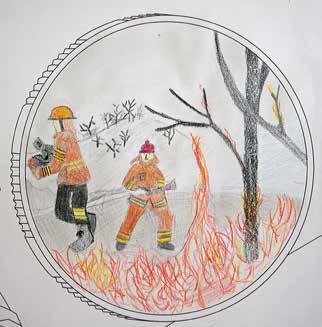
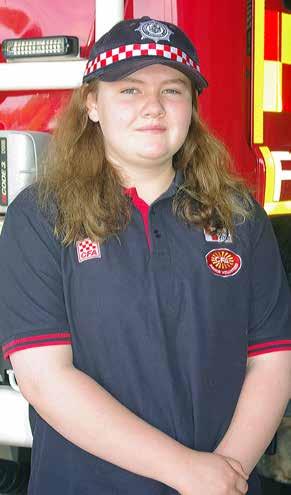
Clancy leads the way to recovery
Clancy Quirk joined Morwell Fire Brigade as a Junior member just over four years ago and has served as the brigade’s Junior crew leader for the past two years. He was also awarded the Junior Firefighter of the Year in 2019. In 2019 Clancy was selected, along with 12 other Junior members, to represent CFA at the Australian Fire Cadet Championships in Sydney. At the Championships, CFA competed against other agencies in a range of firefighting and strategic events which developed their teamwork skills and knowledge of firefighting tactics. “I think our teams demonstrated that CFA has a strong Juniors program that strives to practise CFA’s important values of safety, teamwork, adaptable, integrity and respect,” Clancy said. More recently, Clancy was selected to be a member of the Youth Affairs Council Victoria’s (YACVic) Bushfire Recovery Working Group. YACVic is the peak body and leading policy advocate for young people and the youth sector in Victoria. The main goal of the working group is to enable the Victorian Government to hear directly from young people in rural and regional communities about the response to, and recovery from, the 2019-20 bushfires across Eastern Victoria. The working group also seeks to build on members’ experiences and ideas to develop better ways to support affected youth in future disasters. As a result of COVID-19, the meetings were unable to be held face-to-face and instead took place through online video. Describing the work of the group Clancy said, “We are also running training workshops on youth advocacy and leadership. These workshops enable young people to have a voice, ensuring they are included in important aspects of decision-making, project design and delivery. “My new-found role with YACVic has been a great experience, and I hope the work we’ve done will strengthen ties between CFA, YACVic and smaller regional communities.” Reflecting on his time with CFA Clancy said, “So far it has been a great experience. I’ve developed good friendships with some fantastic people and have been fortunate enough to have been able to participate in some great opportunities with CFA.” Clancy can see himself continuing his involvement with CFA. “My time with CFA so far has taught me a lot. I enjoy what I do and I hope that moving forward as a career I can somehow be involved with CFA. In the meantime, I hope to continue my involvement with my local brigade.” You can find out more about the work Clancy is doing with YACVic and the Bushfire Recovery Working Group at yacvic.org.au/get-involved/are-you-12to-25/bushfire-recovery.
